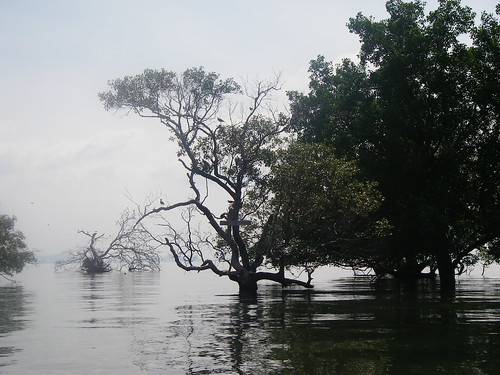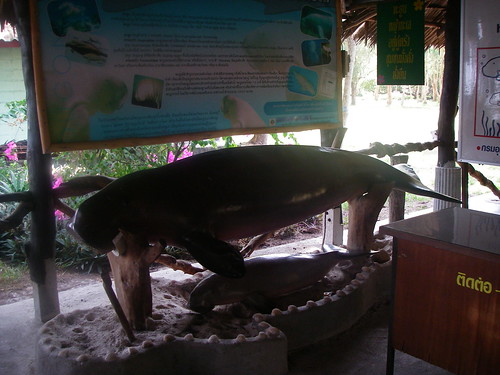Dugong Tour
“Your new life begins tomorrow,” the Professor said.
We were in the bar, listening to the briefing he gave us about the tour.
“Seeing a dugong brings luck. Your life will change. Things are not the same afterwards…”
We were about to ask him what he meant with this mysterious statement when one of the children shrieked. I leaned across from my table to be confronted with an enormous cockroach scuttling past the half-empty dinner plates. The Professor shoo-ed it away.
“I’m sorry. Those creatures are completely harmless, but I’m afraid there are everywhere around the villages.”
“I think we could do with some luck,” the mother said, letting out a deep breath. I admired her fortitude; had the table not separated me from the roach, I’d have run screaming out of the door, arms flailing in the air.
The Professor suppressed a smile. “Perhaps. But back to the tour. Don’t worry if you don’t see any dugongs. There are no guarantees, but it doesn’t mean bad luck. It just means that your time hasn’t come yet.”
*
The longtail floated in the calm sea, illuminated by soft morning light. All three kayaks were tied to its stern. I felt a pang of guilt because I hadn’t helped to clean up the mess I’d made yesterday (I had literally been unable to lift the damn thing out of the water, and by the time I had recovered it was dark).
Today would be so much easier!
We climbed on board and sat down in the shade of the awning while our Chao Ley skipper cast off and agilely stepped along the gunwale to take the steering wheel.
The sea started to pick up, its surface rippling gently, just as it had done yesterday. Five minutes after we’d set out I saw another dolphin-sized splash. By now I was convinced that it was a fish, but what a fish!
It took us just over ten minutes to get to Stationary Beach, which the map labels as Laem Muda. The boat slowed just before we turned into the eastern bay. I squinted into the glare, but saw nothing.
Within a few minutes, another longtail arrived. It had farang on board but no kayaks. We all stared out to sea, but saw nothing apart from the gently rippling waves and small splashing fish.
“There,” The skipper shouted.
Three more minutes passed and the sea had calmed slightly, with fewer fish splashing. Both engines were silent as we continued to stare in vain.
“There!”
I took out my binoculars and started to sweep but still I saw nothing while our skipper made one call after another. As if that wasn’t bad enough, I lost vision in the left lens. I don’t know whether it was smudged or something was lodged inside, but it wouldn’t budge.
*
“The Chao Ley are the best stewards for the marine environment,” the Professor said. “They grow up with the sea. They can see underwater. Not like us. They can grab a fish with their bare hands!”
Until recently, the Chao Ley—or Sea Gypsies—have led a nomadic life, travelling across the Pacific and Indian Ocean in their wooden boats as many of them still do in Indonesia. But more and more are settling down as they are forced to assimilate into a country.
“Otherwise they’ll be kicked out,” the Professor said. “But they belong to the sea. They’re international, from here all the way to Africa. It’s reflected in their music and their songs.”
“Do they really see differently underwater—I mean, do they have different vision from us?” the Swedish Engineer asked, still contemplating the first statement.
“No they don’t have different vision. They’re trained to see things that you’d never notice.”
*
I don’t know how many times the skipper called out while we all strained our eyes in vain. Maybe he was having us on. He might claim we could not see the dugongs that in fact weren’t there.
“You still don’t see it? Big! Hundred kilos!”
By now a police RIB had appeared on the scene, the officers watching us from a distance. They had approached quietly enough not to worry whatever dugongs were not around, but I was puzzled by their appearance. I hadn’t seen any sign of cops yesterday during ten hours on the water. I couldn’t help thinking that they were showing off.
The skipper pulled the kayaks close and signalled for us to get in. The Swedish Engineer shared a kayak with me. He was much more proficient and I couldn’t help thinking that he should have taken one of the kids, but that would mean that I’d have to take charge of one of the remaining two and I could see where the parents might be worried. In either case we quickly set off out to sea. When we were about twice as far from shore as the longtail, the Swede called out.
“A back! I’ve seen its back!”
And three minutes later, there it was, a tiny spot surfacing about 4/5th westward from the eastern corner of Stationary Beach. A real life dugong.
We paddled back across a calming sea, but I didn’t see it again, just a ripple which might have been its snout.
The skipper fired up the engine and we turned into the bay. As if by magic, the left lens of my binoculars cleared suddenly, leaving me to sweep across the sea with the sun now at my back.
“Any dugongs here?”
The skipper shook his head. “No dugong.”
No dugong but birds and beatiful, serene mangroves.
The next time we saw a dugong, it was made of wood-like plastic and graced the tiny forest ranger museum. A mother and child stood next to it.
“Baah!” The little boy shrieked.
“Bra Pa-yoon,” the mother answered. Dugong.
“Yoon! Ba-yoon!”
I hope he grows up to get to know the real thing.
The skipper had a bonus in store. The kids and their mother hadn’t seen any dugongs from the kayaks, having stayed closer to shore, so he took us to the northern side of the island, almost half-way between the rangers’ station and what I assume is Had Yao. Again, he stopped the engine.
“There are dugongs here?” This wasn’t a sheltered area. Far from it. But it had been subject to many transect flights1.
The skipper nodded and gestured for my binoculars. I handed them over and this time it was a good while before he signalled, not saying anything at first. After ten minutes he finally pointed to the back of the boat.
Nope, still nothing.
Another longtail puttered past not far from us, perhaps the ferry to Bran Pow village which is Libong’s population centre and where I had arrived. Before it reached us, ripples appeared close to its path.
“Dugong!”
And again, less than two minutes later, well behind where it had passed. Definitely a dugong. Another three minutes after that, there were more ripples at the same spot.
Barely a minute later there was a splash, closer to shore. Were there more than one?
I was keeping time. Ninety-two seconds passed until the next surfacing back at the previous position, but now it seemed to be approaching our boat. An audible breath followed twenty-seven seconds after that, more ripples—closer still—nineteen seconds later…
Fourteen seconds after that I saw ripples further out towards the island. There had to be be more than one animal.
And suddenly: the back of a head, nostrils submerged, grey-brown—a colour that I have never seen before. The dugon’s back arched no more than an arm’s length away as it dived directly underneath our boat.
And with that it was gone. How many had there been? From the frequent sightings (2-3 a minute) at the same spot, I’d reckon at least a mother and calf. But maybe more. Watching from a boat doesn’t scratch the surface. Groups of half a dozen or more are not uncommon1.
We waited until the dugongs were safely distant, then the skipper re-engaged the engine to complete our trip around the island. He took us snorkelling in a spot where we saw the biggest porcupine fish I’ve ever seen. Its head was the size of a football.
1http://www.warthai.org/files/AerialSurvey_Jan%202008.pdf
Tags: Dugongs, SE Asia, Travel, Tag Index


